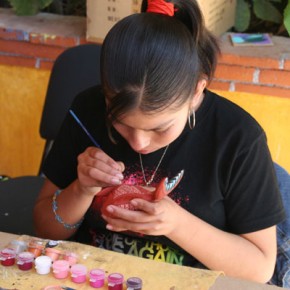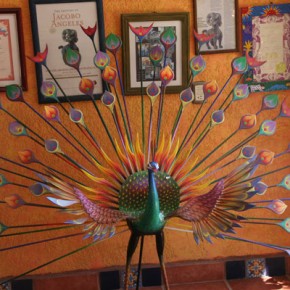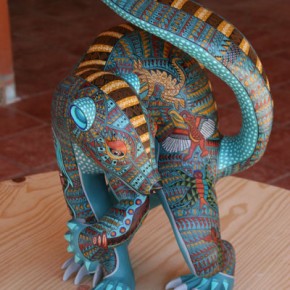The valley surrounding Oaxaca is known for archaeological sites and a variety of artistic handicrafts. The most stunning are the intricately painted wooden alebrijes.
Tourists have no trouble finding reason to visit Mexico’s southern state of Oaxaca. Wildlife, archaeological wonders, unique handicrafts and a mixed culture resistant to modernization draw visitors from around the world.
The State of Oaxaca and its Capital
The size of Indiana, the state of Oaxaca consists of nearly 37,000 square miles of tropical deciduous forest, mountain ranges, high valleys and Pacific Ocean coastline. The capital city bears the same name as the state, Oaxaca, and sits 5,000 feet above sea level. Reflective of the state’s diversity and cultural background, sixteen separate indigenous languages are still spoken in addition to Spanish.
The spectacular Mesoamerican metropolis of Monte Alban ruled the area for 1,200 years, and its ruins are just six miles from the city’s center. Monte Alban is but one of numerous archaeological sites in the state, which also is home to the significant ruins at Mitla and Yagul. Many villages feature tianguis, or open air native markets, serving social as well as commercial needs. Natural beauty and wildlife offer additional reasons to visit, and more than 800 species of birds populate the area, making it one of the most interesting places in Mexico to watch and photograph birds.
The valleys of Zimatlan and Ocotlan, south of Oaxaca, are famous for handicrafts and art, and many of the valley villages specialize in a single product. San Bartolo Coyotepec, for example, is renowned for the lightweight black pottery, barro negro, and almost every home in Teotitlan del Valle is a textile factory where tapetes, or wool carpets, are hand crafted with natural dyes and hand looms. Two villages, Arrozola and San Martin Tilcajete, are the places to find alebrijes, the world-famous wooden sculptures.
The Alebrijes of San Martin Tilcajete
San Martin Tilcajete is about twenty miles south of Oaxaca, and the primary source of alebrijes. Numerous family-owned businesses line the streets, carving, painting and selling the fanciful sculptures from their homes. Alebrijes can be found in fine shops throughout the United States and around the world, but the best prices clearly are found at the sources near Oaxaca. The most famous of the factory shops in San Martin Tilcajete, and the one commanding the highest prices, is that of Jacobo and Maria Angeles.
The Angeles factory shop is entered through a gated courtyard, and the expansive grounds include raw Copal branches, shelves of carved, but unpainted, animals and fantasy creatures, tables where dozens of artists prep and paint the carvings and a large showroom filled with finished artwork. Numerous framed certificates and awards of excellence line the walls, as well, attesting to the artists’ skill. Jacobo Angeles Ojeda is the master artist, and often is presenting his work in distant locations, such as Tucson.
Many of the alebrijes, which range from small coffee-cup sized pieces to major table top museum quality sculptures, are designed as recognizable animals, including rabbits, lizards, coyotes and bulls. Others are fanciful creatures, like devils and dragons. All are cleverly carved and intricately painted with a multitude of bright and vivid colors. Prices for the alebrijes at Jacobo and Maria Angeles’ shop range from a few dollars to thousands of dollars, and if the perfect piece is not found on the shelves, the artists will custom develop a sculpture to meet any customer’s wishes.
Although no visitor should miss Jacobo’s factory shop, one would be well-advised to explore the village and check other shops. Near-comparable artistry can be found at several other home shops in Tilcajete, and less world-wide recognition often means lower prices.
The Handicrafts of Oaxaca
Oaxaca and the surrounding villages are a great source for pottery, textiles and other hand-made arts and crafts. Tourists will find much to admire and purchase, but nothing quite as irresistible as the whimsical alebrijes of Arrozola and San Martin Tilcajete.
- Artist at Work in Jacobo’s Shop near Oaxaca. Photo by Bob Bowers.
- Peacock Alebrije at Ojeda’s Shop in Tilcajete. Photo by Bob Bowers.
- Intricate Alebrije of a Rabbit, Ojeda’s Tilcajete Shop. Photo by Bob Bowers.
- Coati Alebrije, Jacobo Angeles Ojeda, Tilcajete, Mexico. Photo by Bob Bowers.








